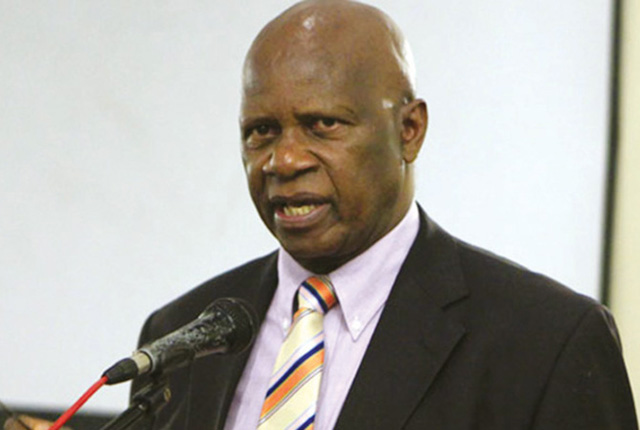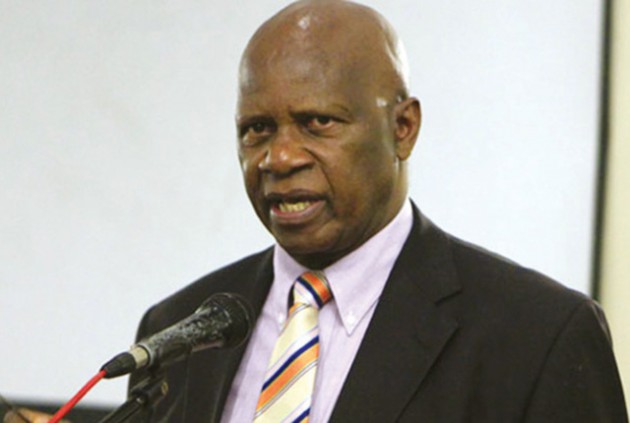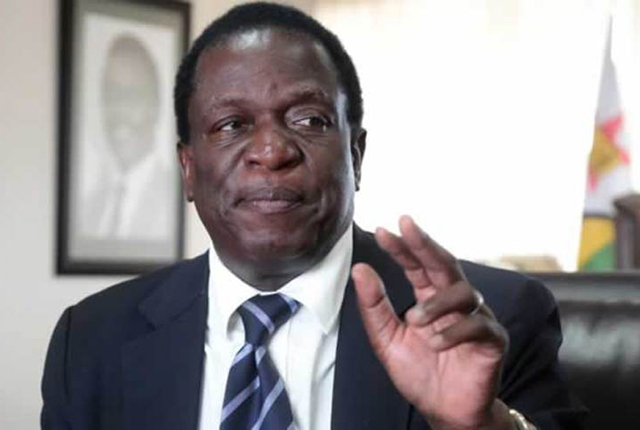There is light at the end of the tunnel

We publish here a presentation by Finance and Economic Development Minister Patrick Chinamasa to military officers attending Joint Command and Staff Course Number 30 at Zimbabwe Staff College yesterday.
Topic: Attracting international institutions to support the revival of Zimbabwe’s economy: Challenges and strategies
Introduction
1. Let me start by extending a special welcome to you all. To our visitors, take time to enjoy Zimbabwe’s hospitality. I have always told previous participants that you are our ambassadors because what you get to hear about Zimbabwe is different from what is obtaining on the ground.
2. The Government of Zimbabwe remains committed to resolving our country’s socio-economic challenges that are essentially transitory. We just need to raise production and productivity levels across all sectors of the economy.
3. Zimbabwe needs a robust private sector because it is this sector that serves as a magnet for international capital. The private sector should lead our development process, and the Government’s role is to create an enabling environment for profitable economic activities by promoting policy clarity, consistency and predictability.
4. My discussion will focus on:
- State of the economy;
- Challenges Zimbabwe is facing in trying to attract international support;
- Strategies that we are currently implementing.
- State of the economy
5. The country’s economic situation is gradually improving due to pragmatic policies that the Government has been implementing. We now have a fairly solid foundation for sustainable recovery.
6. I will restrict my discussion on the state of the economy to the following issues:
- Food security;
- Industry capacity utilisation ; and
- Liquidity conditions.
Food security
7. Food security is key to promoting peace in any economy. A hungry population is a threat to peace and stability.
8. Government has also been paying fairly good prices, US$390 per tonne of maize, delivered to the Grain Marketing Board. Further, we have been able to pay farmers on time for their deliveries.
9. As a result our Strategic Grain Reserves (SGR) stand at about 250 000 tonnes that is equivalent to about 6 months’ cover at a draw-down rate of 41,189 tonnes per month.
10. Further, we expect an excellent harvest of about 3 million tonnes of maize during the current agricultural season largely due to:
- Good rains;
- Initiatives by Government that include Command Agriculture, ARDA Graduation Farming Programme, mechanisation, rehabilitation of irrigation infrastructure as well as input support programmes for vulnerable households; and
- Active participation of the private sector as they realised that they cannot leave “everything” to the Government. We are one family, Government and the private sector, and working together is vital to the country’s sustainable development.
Industry capacity utilisation
11. The imposition of sanctions, hyperinflationary conditions during the 1997 – 2008, influx of cheap imports, high cost of doing of doing business and weak business linkages among others negatively affected the growth of our industry.
12. Some of the initiatives that the Government introduced to address these challenges include:
- International re-engagement;
- Adopting a multi-currency system to tame inflation in 2009;
- Gazetting of Statutory Instrument 64 of 2016;
- Promoting the Buy Zimbabwe Agenda;
- Effective management of foreign currency by the Reserve Bank of Zimbabwe;
- Ease and cost of doing business reforms; and
- Promoting business linkages across all sectors of the economy.
13. As a result of some of these initiatives, we have seen the level of industry capacity utilisation rising from 34 percent in 2015 to current levels of over 50 percent depending on the sub-sector.
Liquidity conditions
14. Despite the country’s liquidity challenges, the banking sector has remained fairly stable with capital levels ranging between US$40 million and US$246.6 million against a minimum of US$25 million.
The prudential liquidity ratio stood at 61.9 percent compared with a minimum regulatory requirement of 30 percent as at 31 December 2016.
15. Long queues outside the banks are being experienced particularly during month-ends. Government is promoting the use of electronic payments (plastic money) in order to reduce pressure on the demand for physical cash.
A total of 32 540 Point of Sale (POS) machines had been deployed as at 31 December 2016.
Further, the Reserve Bank reduced the charges for using electronic payment platforms.
16. It should, however, be noted that liquidity conditions are a function of Domestic Resource Mobilisation, external trade balance, diaspora remittances, inward foreign investments and external loans. I will make brief comments on the performance of these sources and Government interventions starting with Domestic Resource Mobilisation.
Domestic resource mobilisation
17. Domestic resource mobilisation efforts are underpinned by:
- Domestic savings; and
- Tax revenues accruing to Treasury.
18. Domestic savings have remained low and largely short-term. Demand and time deposits accounted for 81.5 percent of total deposits as at 31 December 2016. We do not expect this profile to have changed significantly in January and February this year.
19. Government has instituted measures to enhance tax collection efficiency, curb revenue leakages and corruption through:
- Automating ZIMRA tax management system;
- Fiscalising VAT payments;
- Introducing an electronic cargo tracking system to monitor transit traffic;
- Installing Closed Circuit Televisions (CCTVs) at our border posts; and
- Capacitating ZIMRA with relevant skills to detect transfer pricing and other techniques to deal with illicit financial flows.
20. The implementation of these measures has already started yielding positive results. ZIMRA met its revenue target for the first two months this year.
External trade balance
21. Current account deficit — we are spending more than what the country is generating from exports due to export market concentration and reliance on commodity exports.
22. Government has introduced some measures to correct the situation. I have already discussed some of these measures when I was looking to efforts to raise domestic industry capacity utilisation. We need a robust domestic industry that produces for both the domestic and external markets. This will help reduce the reliance on compressible imports and diversifying our exports from commodities.
23. The introduction of an Export Incentive Scheme financed through bond notes has had a positive impact on the production of tobacco and gold. As a result we expect:
- 200 – 215 million kilogrammes of tobacco this season; and
- An increase in gold production from 21.4 tonnes in 2016 to 25 tonnes this year.
24. Therefore, the opening up of tobacco auction floors this month will go a long way in boosting our foreign currency situation.
Diaspora remittances
25. Diaspora remittances declined by from US$939 million in 2015 to US$779 million in 2016. The introduction of Diaspora Remittance Incentive Scheme is expected to increase the remittances sent through formal channels.
Inward foreign direct investment
26. Inward foreign direct investment remains low due to the high cost of doing business and perceived country risk among other factors. Foreign direct investment declined from US$399.2 million in 2015 to US$254.7 million last year.
External loans developments
27. The Reserve Bank approved and registered a total of 247 facilities valued at US$1.866 billion in 2016 compared with US$1.816 billion in 2015.
28. Agricultural and financial sectors attracted 48 percent and 21 percent of the loans received in 2016 respectively while the other sectors received between one percent and eight percent.
Challenges in attracting international support
29. Two main challenges that are stalling Zimbabwe’s efforts to attract international support are:
- Sanctions; and
- External debt overhang.
30. These are closely related because the country’s external debt situation can be attributed to the sanctions that crippled our ability to honour our international obligations.
Sanctions
31. The events that led to a bilateral misunderstanding between Zimbabwe and the UK are:
- In 1979, at the Lancaster House Conference, the UK Government under Prime Minister M. Thatcher and the USA Administration under President Carter pledged to make resources available towards the financing of the Land Reform and Redistribution Programme as well as the payment of compensation to former farm owners.
However, the new USA Administration under President Regan reneged on the commitment made by President Carter. Subsequently the Labour Party under Prime Minister T. Blair also reneged on the pledge. This infuriated Zimbabweans resulting in the Government of Zimbabwe embarking on a fast-track Land Reform and Distribution Programme.
32. Our bilateral dispute with the UK was internationalised leading to the imposition of sanctions against Zimbabwe by the European Union and USA.
33. Europe has, however, been softening its stance on Zimbabwe, while the USA has been tightening her position. You all know that USA is the world’s largest economy and literally controls the global financial system!
34. We continue to engage USA and Europe in order to normalise our relations because sanctions continue to hurt Zimbabwe. Zimbabwe is like a pariah state in the global financial markets. International financiers and investors are sceptical about dealing with Zimbabwe because they wait for signals from their Governments.
External debt overhang
35. The country has also been struggling with a US$7.5 billion external debt, with arrears accounting for 69% of this amount. This has been militating against our efforts to mobilise reasonably priced long-term credit. The limited loans on the domestic market are attracting punitive interest rates that are retarding economic recovery.
36. Reintegrating Zimbabwe back into the global economy will enable us to start enjoying the benefits of being a member of Multilateral Financial Institutions and also accessing international credit at affordable interest rates.
37. We have since cleared our obligations to the International Monetary Fund (IMF) using our Special Drawings Rights (SDRs). Removal of Zimbabwe from the IMF remedial measures is expected to positively impact on the country’s risk rating in global financial markets. This should help attract the much needed foreign investment.
38. We continue to engage the international creditors in order to address the problem of external debt arrears and restore relations. We will do everything that is within our powers as the Government to restore international relations.
Other Policy Interventions
Resolving the land dispute
39. Government has taken steps to unlock value from the land acquired under the Land Reform Programme in order to enhance agricultural production.
40. Measures already undertaken include the following:
· Fixing new boundaries;
· Issuance of A1 permits and 99 year leases for A2 farmers; and
· Evaluation of compensation to BIPPA farm owners and former farmers.
41. The implementation of these measures will help boost agricultural productivity through enhanced access to finance.
Creating a conducive investment climate
42. The following are some of the measures that are being implemented by Government in order to promote private sector growth:
- Addressing the ease and cost of doing business;
- Establishing Special Economic Zones; and
- Promoting anchor financing models.
43. I have already announced fiscal incentives for investments in Special Economic Zones and those anchor companies that will help promote business linkages across all sectors of the economy.
Conclusion
44. The efforts made to date are aimed at enhancing our business environment and make Zimbabwe an attractive investment destination. We are also strengthening the role of the domestic private sector given their strategic importance in attracting international capital.
45. Government is also addressing structural bottlenecks that are militating against our recovery efforts, especially infrastructural issues, productivity and competitiveness.
46. I thank you for your kind attention.










Comments